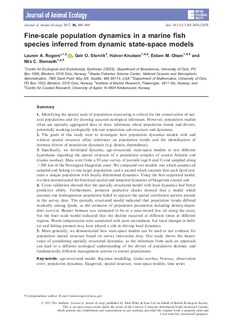| dc.contributor.author | Rogers, Lauren | |
| dc.contributor.author | Storvik, Geir Olve | |
| dc.contributor.author | Knutsen, Halvor | |
| dc.contributor.author | Olsen, Esben Moland | |
| dc.contributor.author | Stenseth, Nils Christian | |
| dc.date.accessioned | 2018-02-13T13:01:03Z | |
| dc.date.available | 2018-02-13T13:01:03Z | |
| dc.date.created | 2017-05-08T12:15:51Z | |
| dc.date.issued | 2017 | |
| dc.identifier.citation | Journal of Animal Ecology. 2017, 86 (4), 888-898. | nb_NO |
| dc.identifier.issn | 0021-8790 | |
| dc.identifier.uri | http://hdl.handle.net/11250/2484398 | |
| dc.description.abstract | Identifying the spatial scale of population structuring is critical for the conservation of natural populations and for drawing accurate ecological inferences. However, population studies often use spatially aggregated data to draw inferences about population trends and drivers, potentially masking ecologically relevant population sub-structure and dynamics. The goals of this study were to investigate how population dynamics models with and without spatial structure affect inferences on population trends and the identification of intrinsic drivers of population dynamics (e.g. density dependence). Specifically, we developed dynamic, age-structured, state-space models to test different hypotheses regarding the spatial structure of a population complex of coastal Atlantic cod (Gadus morhua). Data were from a 93-year survey of juvenile (age 0 and 1) cod sampled along >200 km of the Norwegian Skagerrak coast. We compared two models: one which assumes all sampled cod belong to one larger population, and a second which assumes that each fjord contains a unique population with locally determined dynamics. Using the best supported model, we then reconstructed the historical spatial and temporal dynamics of Skagerrak coastal cod. Cross-validation showed that the spatially structured model with local dynamics had better predictive ability. Furthermore, posterior predictive checks showed that a model which assumes one homogeneous population failed to capture the spatial correlation pattern present in the survey data. The spatially structured model indicated that population trends differed markedly among fjords, as did estimates of population parameters including density-dependent survival. Recent biomass was estimated to be at a near-record low all along the coast, but the finer scale model indicated that the decline occurred at different times in different regions. Warm temperatures were associated with poor recruitment, but local changes in habitat and fishing pressure may have played a role in driving local dynamics. More generally, we demonstrated how state-space models can be used to test evidence for population spatial structure based on survey time-series data. Our study shows the importance of considering spatially structured dynamics, as the inferences from such an approach can lead to a different ecological understanding of the drivers of population declines, and fundamentally different management actions to restore populations. | nb_NO |
| dc.language.iso | eng | nb_NO |
| dc.publisher | Wiley | nb_NO |
| dc.rights | Attribution-NonCommercial-NoDerivatives 4.0 Internasjonal | * |
| dc.rights | Attribution-NonCommercial-NoDerivatives 4.0 Internasjonal | * |
| dc.rights.uri | http://creativecommons.org/licenses/by-nc-nd/4.0/deed.no | * |
| dc.title | Fine-scale population dynamics in a marine fish species inferred from dynamic state-space models | nb_NO |
| dc.type | Journal article | nb_NO |
| dc.type | Peer reviewed | nb_NO |
| dc.description.version | publishedVersion | nb_NO |
| dc.source.pagenumber | 888-898 | nb_NO |
| dc.source.volume | 86 | nb_NO |
| dc.source.journal | Journal of Animal Ecology | nb_NO |
| dc.source.issue | 4 | nb_NO |
| dc.identifier.doi | 10.1111/1365-2656.12678 | |
| dc.identifier.cristin | 1468786 | |
| dc.description.localcode | nivå2 | nb_NO |
| cristin.unitcode | 201,15,2,0 | |
| cristin.unitname | Institutt for naturvitenskapelige fag | |
| cristin.ispublished | true | |
| cristin.fulltext | original | |
| cristin.qualitycode | 2 | |

